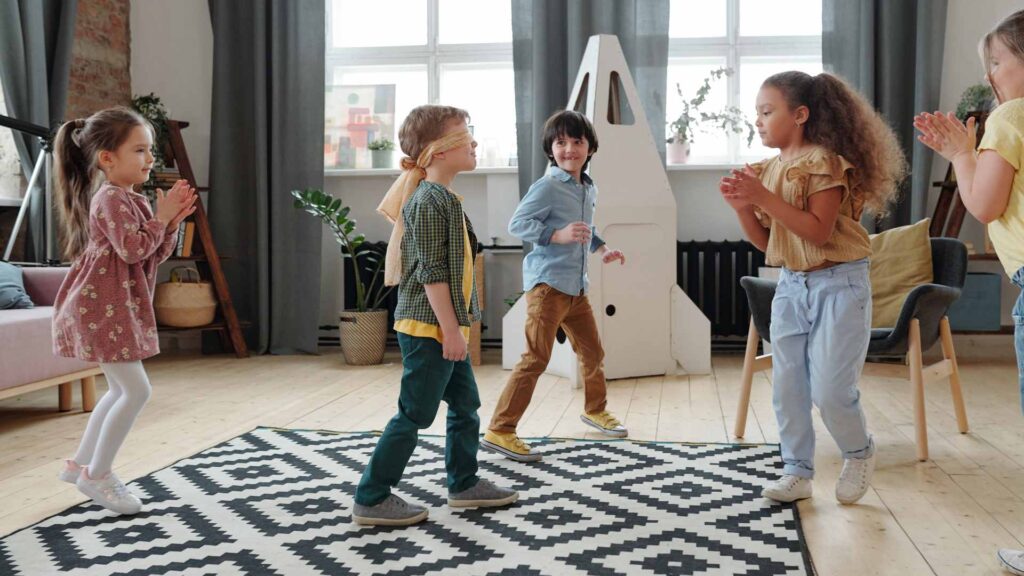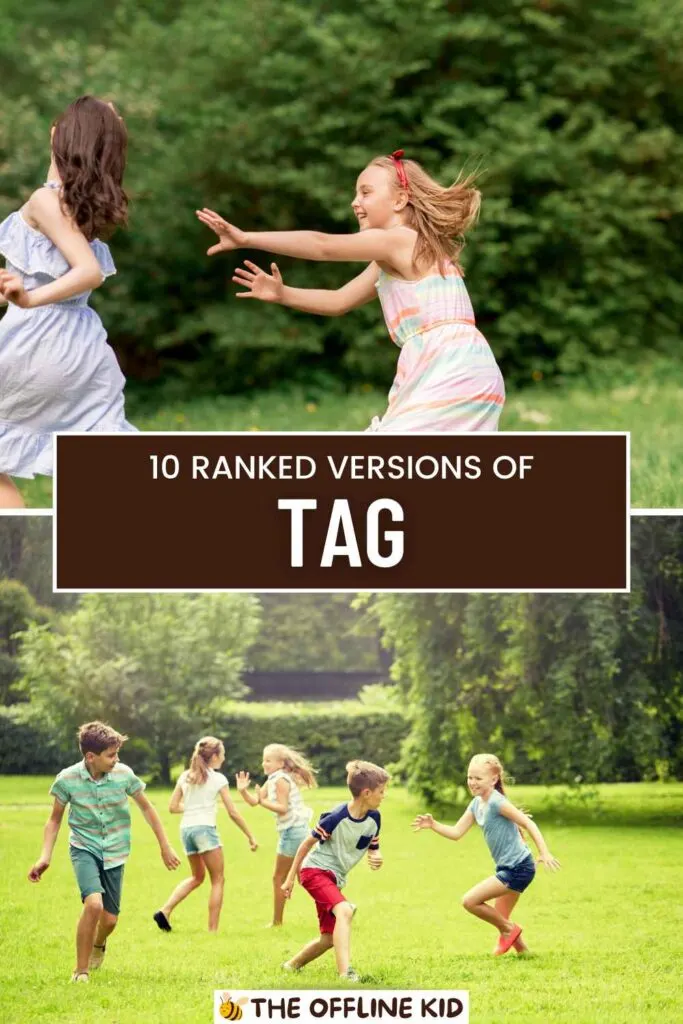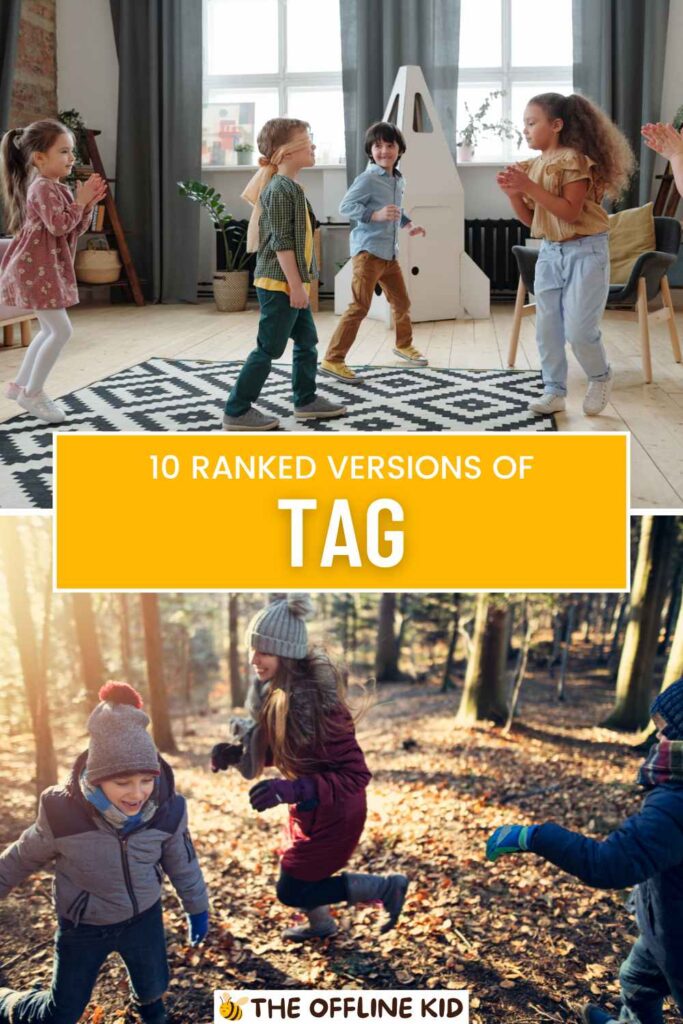Discover the most exciting and fun-filled versions of tag for kids!
From classic tag to creative twists like Zombie Tag, this guide ranks the top 10 tag games that will keep children active and entertained.
Classic Tag
Tag is the quintessential playground game that has stood the test of time.
Classic Tag is straightforward, easy to understand, and endlessly fun. Here’s everything you need to know to get started.
Description and Rules
In Classic Tag, one player is “It” and must chase and tag the other players. Once tagged, that player becomes “It,” and the game continues.
Basic Rules:
- One player starts as “It.”
- “It” must tag another player by touching them.
- The tagged player becomes the new “It.”
- No tagging the person who just tagged you (no tag-backs).
Why It’s a Favorite
Classic Tag remains a favorite because of its simplicity and the excitement of the chase. It’s easy to organize and requires no equipment, making it perfect for spontaneous play.
Tips for Playing
- Set Boundaries: Establish clear play boundaries to keep the game safe and contained.
- Safe Zones: Introduce safe zones where players can’t be tagged to add strategy and rest points.
- Tagging Etiquette: Encourage gentle tagging to avoid injuries and ensure everyone has fun.
Variations and Keeping It Interesting
To keep Classic Tag fresh and exciting, try these variations:
- Timed Rounds: Play in short, timed rounds with a whistle or timer to add urgency.
- Team Tag: Split into teams, where one team is “It” and must tag players on the other team.
- Obstacle Tag: Incorporate playground equipment or natural obstacles to increase the challenge.
Classic Tag is more than just a game; it’s a way for kids to exercise, socialize, and develop their coordination and strategic thinking.
With its endless adaptability and timeless appeal, Classic Tag is a must-have in any list of top tag games.
Freeze Tag
Freeze Tag brings an exciting twist to the classic game by incorporating elements of teamwork and strategy. This version adds an extra layer of fun and keeps players on their toes.
Description and Rules
In Freeze Tag, the game begins similarly to Classic Tag, but with an important difference: when players are tagged, they must “freeze” in place and can only be “unfrozen” by another player.
Basic Rules:
- One player starts as “It.”
- When “It” tags a player, the tagged player must freeze and stay in place.
- Frozen players can be unfrozen if another player touches them.
- The game continues until all players are frozen or a predetermined time limit is reached.
How It Differs from Classic Tag
Freeze Tag adds a cooperative element, as players must work together to unfreeze each other. This dynamic encourages teamwork and makes the game more engaging.
Strategies for Winning
- Stay Close to Friends: Keep an eye on your friends and stay within reach to unfreeze them quickly.
- Distract “It”: Use clever tactics to distract “It” and give your teammates a chance to move freely.
- Rotate Roles: Switch who plays “It” regularly to keep the game balanced and fair.
Benefits of Freeze Tag for Kids
- Teamwork: Encourages kids to work together and help each other.
- Coordination: Enhances physical coordination as players move and freeze quickly.
- Strategic Thinking: Develops strategic thinking as players plan how to unfreeze teammates and avoid being tagged.
Freeze Tag is a fantastic way to combine physical activity with social skills. Its unique rules and cooperative nature make it a standout choice among tag games, ensuring hours of fun for kids of all ages.
Blob Tag
Blob Tag introduces a collaborative and slightly chaotic twist to traditional tag games. As players get tagged, they join hands with “It,” forming a growing “blob” that adds to the excitement.
Description and Rules
In Blob Tag, the game starts with one player as “It,” but instead of tagging players to make them “It,” they join hands and become part of the “blob.” The blob continues to grow as more players are tagged.
Basic Rules:
- One player starts as “It.”
- When “It” tags a player, they join hands to form a “blob.”
- The blob must work together to tag other players.
- The game continues until all players are part of the blob or a set time limit is reached.
How to Form the “Blob”
- Tagging: When “It” tags a player, the tagged player joins hands with “It.”
- Growing Blob: The blob continues to tag players, who then join the chain.
- Coordination: As the blob grows, players must coordinate their movements to tag others effectively.
Challenges and Excitement of Blob Tag
- Coordination: The growing blob must move together, making coordination a fun challenge.
- Strategy: Players not in the blob must think strategically to avoid being tagged.
- Teamwork: The blob requires teamwork to move efficiently and tag others.
Ideal Settings and Group Sizes
- Open Spaces: Large, open areas are best to allow the blob to move freely without obstacles.
- Medium to Large Groups: Blob Tag works best with medium to large groups, ideally 10 or more players, to keep the game dynamic and engaging.
Blob Tag is a thrilling variation that encourages collaboration and teamwork. The growing blob creates an exciting dynamic, making each round unpredictable and filled with laughter.
Whether played in a park or a playground, Blob Tag is sure to be a hit with kids looking for a fun and challenging game.

Zombie Tag
Zombie Tag adds a spooky and imaginative twist to the traditional game of tag, bringing elements of role-play and creative movement. This version is perfect for kids who enjoy a bit of drama and excitement.
Description and Rules
In Zombie Tag, one player starts as the “Zombie” and must tag other players to turn them into zombies. As more players become zombies, the game gets more thrilling and chaotic.
Basic Rules:
- One player begins as the “Zombie.”
- When the Zombie tags a player, that player also becomes a Zombie.
- The game continues until all players are turned into Zombies or a set time limit is reached.
- Zombies must move in a specific way (e.g., slow and staggering) to add to the atmosphere.
The Thrill of Playing Zombie Tag
- Role-Playing: Players enjoy acting like zombies, adding a fun and dramatic element to the game.
- Increased Challenge: As more players become zombies, the remaining humans must work harder to avoid being tagged.
- Atmosphere: Playing Zombie Tag in the evening or during Halloween can enhance the spooky ambiance.
Creative Zombie Roles and Actions
- Zombie Movements: Encourage creative movements like staggering, limping, or dragging feet to make the game more fun.
- Zombie Sounds: Add growls or moans to heighten the experience.
- Zombie Variations: Introduce different types of zombies with unique abilities (e.g., fast zombies or sneaky zombies) for added complexity.
Tips for Safe Play
- Clear Boundaries: Define the play area to ensure safety and prevent players from wandering too far.
- Safe Zones: Establish safe zones where players can rest or strategize without fear of being tagged.
- Gentle Tagging: Remind players to tag gently to avoid injuries.
Zombie Tag is a favorite for its blend of imaginative play and physical activity. It’s a great way for kids to engage in role-playing while enjoying the classic game of tag. Whether played in the backyard or at a themed party, Zombie Tag is sure to be a memorable experience for all involved.
Shadow Tag
Shadow Tag is a unique and creative version of tag that relies on the sun and shadows to create an engaging and challenging game. It’s perfect for sunny days and encourages kids to be mindful of their surroundings.
Description and Rules
In Shadow Tag, the game is played just like Classic Tag, but instead of tagging players directly, “It” must step on another player’s shadow to tag them.
Basic Rules:
- One player starts as “It.”
- “It” tags other players by stepping on their shadows.
- Once a player’s shadow is stepped on, they become “It.”
- The game continues until players decide to switch roles or a set time limit is reached.
How to Play with Shadows
- Sunlight: The game requires a sunny day to create distinct shadows.
- Shadow Awareness: Players must be aware of their own and others’ shadows to avoid being tagged.
- Movement Strategy: Use quick and unpredictable movements to make it harder for “It” to step on your shadow.
Best Times of Day for Shadow Tag
- Morning and Late Afternoon: Shadows are longer and more distinct, making the game easier and more exciting.
- Midday: Shadows are shorter, increasing the challenge for both “It” and the other players.
Enhancing the Game with Fun Shadow Tricks
- Shadow Dancing: Encourage players to use creative movements and dances to make their shadows harder to catch.
- Shadow Shapes: Players can experiment with making different shapes with their shadows to add variety.
- Obstacle Shadows: Use natural or artificial obstacles to create complex shadow patterns, adding to the challenge.
Shadow Tag is a fantastic way to incorporate environmental awareness into a fun game. It teaches kids to be observant and think creatively about their movements. Perfect for sunny days in the park or backyard, Shadow Tag provides a fresh and engaging twist on the traditional tag game.
Tunnel Tag
Tunnel Tag introduces an exciting twist to the traditional game of tag by incorporating physical tunnels into the gameplay. This version encourages creativity and physical coordination, making it a favorite among active kids.
Description and Rules
In Tunnel Tag, players create “tunnels” with their bodies that other players must crawl through to be freed after being tagged.
Basic Rules:
- One player starts as “It.”
- When a player is tagged, they must freeze and form a “tunnel” by spreading their legs apart.
- To unfreeze a tagged player, another player must crawl through their legs.
- The game continues until all players are frozen or a set time limit is reached.
Unique Twist of Creating “Tunnels”
- Tunnel Formation: Tagged players form a tunnel by standing with their legs spread apart.
- Unfreezing Players: Players who are not “It” must crawl through the tunnel to unfreeze tagged players.
- Physical Activity: This game involves crawling and coordination, adding a physical challenge.
Physical Benefits and Challenges
- Coordination: Enhances physical coordination as players crawl through tunnels.
- Flexibility: Encourages flexibility and body awareness.
- Teamwork: Players must work together to unfreeze teammates and avoid being tagged.
Tips for Creating Safe Tunnels
- Spacing: Ensure players leave enough space between their legs to prevent accidental kicks or bumps.
- Soft Surfaces: Play on soft grass or a padded surface to make crawling safer.
- Gentle Crawling: Encourage players to crawl gently and be mindful of others to avoid injuries.
Tunnel Tag combines traditional tag with fun physical challenges, making it a hit with kids who enjoy active play.
It promotes teamwork, coordination, and flexibility while adding an exciting new element to the classic game. Perfect for playgrounds, parks, or backyards, Tunnel Tag keeps kids engaged and moving.

TV Tag
TV Tag brings a fun, creative twist to traditional tag by incorporating elements of popular culture. This version encourages quick thinking and knowledge of TV shows and movies, making it a hit with kids who love their screen time.
Description and Rules
In TV Tag, players can avoid being tagged by quickly naming a TV show, movie, or character before “It” can tag them.
Basic Rules:
- One player starts as “It.”
- To avoid being tagged, players must squat down and shout the name of a TV show, movie, or character.
- Players must not repeat names already used in the same round.
- If “It” tags a player before they can name something, that player becomes the new “It.”
How to Incorporate TV Shows and Movies
- Categories: Decide on specific categories (e.g., animated shows, superhero movies) to make the game more challenging.
- Themes: Use themes related to current popular shows or movies for added excitement.
- Character Names: Allow players to use character names to broaden the range of options.
Encouraging Creativity and Quick Thinking
- Speed: Players must think quickly to avoid being tagged, promoting fast thinking and reflexes.
- Variety: Encourage kids to watch a variety of shows and movies to expand their knowledge and make the game more fun.
- Memory: Players must remember which names have already been used to avoid repeating.
Fun TV Tag Themes
- Superheroes: Focus on superhero shows and movies.
- Cartoons: Use classic and modern cartoons as the category.
- Disney: Incorporate Disney movies and characters for a magical twist.
- Holiday Specials: Play during holidays with themes like Christmas movies or Halloween specials.
TV Tag is a fantastic way to blend physical activity with popular culture. It keeps kids engaged by combining their love for TV shows and movies with the excitement of tag.
This version encourages creativity, quick thinking, and a broad knowledge of popular media, making it a perfect choice for kids who enjoy a mix of screen time and outdoor play.
Flashlight Tag
Flashlight Tag adds an element of adventure and mystery to the traditional game of tag by playing in the dark with flashlights. This version is perfect for evenings and brings a whole new level of excitement to the game.
Description and Rules
In Flashlight Tag, players use flashlights to tag each other, with the beam of light acting as the “tag.”
Basic Rules:
- One player starts as “It” and carries a flashlight.
- “It” must use the flashlight beam to tag other players by shining the light on them.
- Once tagged, a player becomes the new “It” and takes the flashlight.
- The game continues until a set time limit is reached or players decide to stop.
Playing in the Dark with Flashlights
- Setting: Play in a safe, open area with minimal obstacles to avoid accidents.
- Visibility: Ensure all players have a flashlight to improve visibility and safety.
- Hiding Spots: Encourage players to find creative hiding spots to avoid the flashlight beam.
Safety Tips for Night Play
- Clear Boundaries: Establish clear play boundaries to keep players within a safe area.
- Buddy System: Pair up players or ensure everyone is accounted for to prevent anyone from getting lost.
- Soft Ground: Play on soft ground to reduce the risk of injury if players trip or fall.
Adding Spooky Elements for Extra Fun
- Costumes: Encourage players to wear fun or spooky costumes to add to the excitement.
- Sound Effects: Use spooky sound effects or music to create an eerie atmosphere.
- Themed Nights: Organize themed Flashlight Tag nights, such as Halloween or ghost stories, to make the game even more thrilling.
Flashlight Tag is a thrilling variation that combines the classic chase with the excitement of playing in the dark. It encourages kids to use their senses, think strategically, and enjoy the thrill of the game.
Perfect for backyard play or camping trips, Flashlight Tag offers a unique and adventurous twist on traditional tag.

Chain Tag
Chain Tag adds a cooperative and dynamic twist to the traditional game of tag by requiring players to form a human chain as they tag others.
This version emphasizes teamwork and coordination, making it both challenging and fun.
Description and Rules
In Chain Tag, the game starts with one player as “It.” As players are tagged, they join hands with “It,” forming a chain. The chain continues to grow as more players are tagged.
Basic Rules:
- One player starts as “It.”
- When a player is tagged, they join hands with “It,” forming a chain.
- The chain must remain connected as it tags other players.
- The game continues until all players are part of the chain or a set time limit is reached.
Forming and Breaking Chains
- Tagging: When “It” tags a player, they join hands, forming a human chain.
- Chain Movement: The chain must move together to tag other players, requiring coordination and communication.
- Breaking Chains: If the chain breaks, it must stop and reconnect before continuing to tag others.
Cooperation and Teamwork Elements
- Coordination: Players in the chain must coordinate their movements to tag others effectively.
- Communication: Effective communication is essential to ensure the chain moves smoothly and stays connected.
- Strategy: Players not in the chain must think strategically to avoid being tagged and consider how to break the chain’s coordination.
Fun Variations to Try
- Double Chain: Form two chains that compete to tag the remaining players, adding an element of competition.
- Chain Relays: Introduce relay-style elements where chains must reach specific points or complete tasks while remaining connected.
- Chain Challenges: Add challenges for the chain, such as navigating obstacles or completing simple tasks together.
Chain Tag is an engaging and cooperative game that brings a new level of excitement to traditional tag. It promotes teamwork, communication, and coordination while providing plenty of fun and physical activity.
Whether played in a park or a playground, Chain Tag offers a dynamic and inclusive experience that kids will love.
Band-Aid Tag
Band-Aid Tag adds a playful and imaginative twist to traditional tag by introducing the concept of “healing” with band-aids.
This version emphasizes empathy and cooperation, making it a great choice for kids who enjoy helping others.
Description and Rules
In Band-Aid Tag, players can be “healed” by their teammates, creating an interactive and supportive environment.
Basic Rules:
- One player starts as “It.”
- When a player is tagged, they must place a hand on the spot where they were tagged, simulating a “band-aid.”
- If a player is tagged a second time, they must place their other hand on the new spot.
- If tagged a third time, they are frozen and must wait for another player to unfreeze them by tagging them.
- The game continues until all players are frozen or a set time limit is reached.
The “Band-Aid” Twist and How It Works
- First Tag: Place one hand on the tagged spot, acting as a band-aid.
- Second Tag: Place the other hand on the new tagged spot.
- Third Tag: Players are frozen and need to be healed by teammates.
- Healing: Unfrozen players can heal frozen players by tagging them, allowing them to continue playing.
Promoting Empathy and Helping Others
- Supportive Play: Encourages players to help and support their teammates, fostering a sense of empathy.
- Teamwork: Players must work together to unfreeze their friends and keep the game going.
- Positive Interaction: Promotes positive interactions and cooperation among players.
Creative Ways to Make the Game More Engaging
- Themed Band-Aids: Introduce themed band-aids (imaginary or real) based on popular characters or colors to add excitement.
- Healing Zones: Designate specific areas as “healing zones” where players can go to unfreeze more quickly.
- Role-Play: Incorporate role-play elements where players can pretend to be doctors or nurses when healing their teammates.
Band-Aid Tag is a delightful variation that combines physical activity with elements of empathy and cooperation.
It encourages kids to be mindful of their teammates and work together, making the game both fun and educational. Perfect for school playgrounds or family gatherings, Band-Aid Tag provides a unique and heartwarming twist on traditional tag games.
Conclusion
Tag games have evolved over time, offering endless variations that cater to different preferences and settings.
From classic tag to creative twists like Flashlight Tag and Band-Aid Tag, each version brings its own excitement and challenges. These games not only promote physical activity but also encourage teamwork, quick thinking, and creativity among players.


